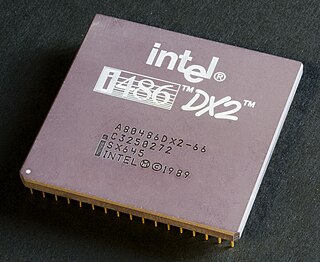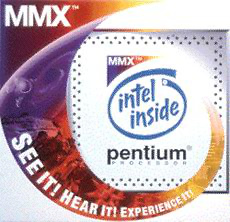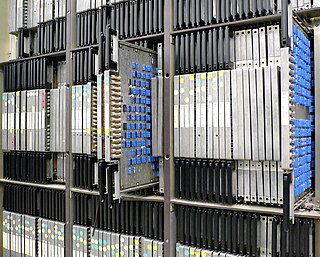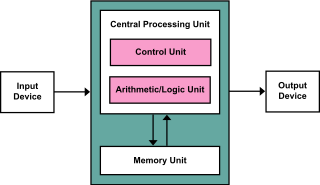
A central processing unit (CPU)—also called a central processor or main processor—is the most important processor in a given computer. Its electronic circuitry executes instructions of a computer program, such as arithmetic, logic, controlling, and input/output (I/O) operations. This role contrasts with that of external components, such as main memory and I/O circuitry, and specialized coprocessors such as graphics processing units (GPUs).

Single instruction, multiple data (SIMD) is a type of parallel processing in Flynn's taxonomy. SIMD can be internal and it can be directly accessible through an instruction set architecture (ISA), but it should not be confused with an ISA. SIMD describes computers with multiple processing elements that perform the same operation on multiple data points simultaneously.

MMX is a single instruction, multiple data (SIMD) instruction set architecture designed by Intel, introduced on January 8, 1997 with its Pentium P5 (microarchitecture) based line of microprocessors, named "Pentium with MMX Technology". It developed out of a similar unit introduced on the Intel i860, and earlier the Intel i750 video pixel processor. MMX is a processor supplementary capability that is supported on IA-32 processors by Intel and other vendors as of 1997.
In computing, a vector processor or array processor is a central processing unit (CPU) that implements an instruction set where its instructions are designed to operate efficiently and effectively on large one-dimensional arrays of data called vectors. This is in contrast to scalar processors, whose instructions operate on single data items only, and in contrast to some of those same scalar processors having additional single instruction, multiple data (SIMD) or SWAR Arithmetic Units. Vector processors can greatly improve performance on certain workloads, notably numerical simulation and similar tasks. Vector processing techniques also operate in video-game console hardware and in graphics accelerators.

A Connection Machine (CM) is a member of a series of massively parallel supercomputers that grew out of doctoral research on alternatives to the traditional von Neumann architecture of computers by Danny Hillis at Massachusetts Institute of Technology (MIT) in the early 1980s. Starting with CM-1, the machines were intended originally for applications in artificial intelligence (AI) and symbolic processing, but later versions found greater success in the field of computational science.

A system on a chip or system-on-chip is an integrated circuit that integrates most or all components of a computer or other electronic system. These components almost always include on-chip central processing unit (CPU), memory interfaces, input/output devices, input/output interfaces, and secondary storage interfaces, often alongside other components such as radio modems and a graphics processing unit (GPU) – all on a single substrate or microchip. SoCs may contain digital, and also analog, mixed-signal, and often radio frequency signal processing functions.

Parallel computing is a type of computation in which many calculations or processes are carried out simultaneously. Large problems can often be divided into smaller ones, which can then be solved at the same time. There are several different forms of parallel computing: bit-level, instruction-level, data, and task parallelism. Parallelism has long been employed in high-performance computing, but has gained broader interest due to the physical constraints preventing frequency scaling. As power consumption by computers has become a concern in recent years, parallel computing has become the dominant paradigm in computer architecture, mainly in the form of multi-core processors.
The Advanced Scientific Computer (ASC) is a supercomputer designed and manufactured by Texas Instruments (TI) between 1966 and 1973. The ASC's central processing unit (CPU) supported vector processing, a performance-enhancing technique which was key to its high-performance. The ASC, along with the Control Data Corporation STAR-100 supercomputer, were the first computers to feature vector processing. However, this technique's potential was not fully realized by either the ASC or STAR-100 due to an insufficient understanding of the technique; it was the Cray Research Cray-1 supercomputer, announced in 1975 that would fully realize and popularize vector processing. The more successful implementation of vector processing in the Cray-1 would demarcate the ASC as first-generation vector processors, with the Cray-1 belonging in the second.

The ILLIAC I, a pioneering computer in the ILLIAC series of computers built in 1952 by the University of Illinois, was the first computer built and owned entirely by a United States educational institution.

The ILLIAC IV was the first massively parallel computer. The system was originally designed to have 256 64-bit floating point units (FPUs) and four central processing units (CPUs) able to process 1 billion operations per second. Due to budget constraints, only a single "quadrant" with 64 FPUs and a single CPU was built. Since the FPUs all had to process the same instruction – ADD, SUB etc. – in modern terminology the design would be considered to be single instruction, multiple data, or SIMD.
Flynn's taxonomy is a classification of computer architectures, proposed by Michael J. Flynn in 1966 and extended in 1972. The classification system has stuck, and it has been used as a tool in the design of modern processors and their functionalities. Since the rise of multiprocessing central processing units (CPUs), a multiprogramming context has evolved as an extension of the classification system. Vector processing, covered by Duncan's taxonomy, is missing from Flynn's work because the Cray-1 was released in 1977: Flynn's second paper was published in 1972.

The von Neumann architecture—also known as the von Neumann model or Princeton architecture—is a computer architecture based on a 1945 description by John von Neumann, and by others, in the First Draft of a Report on the EDVAC. The document describes a design architecture for an electronic digital computer with these components:

In computing, multiple instruction, single data (MISD) is a type of parallel computing architecture where many functional units perform different operations on the same data. Pipeline architectures belong to this type, though a purist might say that the data is different after processing by each stage in the pipeline. Fault tolerance executing the same instructions redundantly in order to detect and mask errors, in a manner known as task replication, may be considered to belong to this type. Applications for this architecture are much less common than MIMD and SIMD, as the latter two are often more appropriate for common data parallel techniques. Specifically, they allow better scaling and use of computational resources. However, one prominent example of MISD in computing are the Space Shuttle flight control computers.
ILLIAC was a series of supercomputers built at a variety of locations, some at the University of Illinois at Urbana–Champaign. In all, five computers were built in this series between 1951 and 1974. Some more modern projects also use the name.
Asynchronous circuit is a sequential digital logic circuit that does not use a global clock circuit or signal generator to synchronize its components. Instead, the components are driven by a handshaking circuit which indicates a completion of a set of instructions. Handshaking works by simple data transfer protocols. Many synchronous circuits were developed in early 1950s as part of bigger asynchronous systems. Asynchronous circuits and theory surrounding is a part of several steps in integrated circuit design, a field of digital electronics engineering.
In computer science, stream processing is a programming paradigm which views data streams, or sequences of events in time, as the central input and output objects of computation. Stream processing encompasses dataflow programming, reactive programming, and distributed data processing. Stream processing systems aim to expose parallel processing for data streams and rely on streaming algorithms for efficient implementation. The software stack for these systems includes components such as programming models and query languages, for expressing computation; stream management systems, for distribution and scheduling; and hardware components for acceleration including floating-point units, graphics processing units, and field-programmable gate arrays.
SIMD within a register (SWAR), also known by the name "packed SIMD" is a technique for performing parallel operations on data contained in a processor register. SIMD stands for single instruction, multiple data. Flynn's 1972 taxonomy categorises SWAR as "pipelined processing".
This glossary of computer hardware terms is a list of definitions of terms and concepts related to computer hardware, i.e. the physical and structural components of computers, architectural issues, and peripheral devices.
John Patrick Hayes is an Irish-American computer scientist and electrical engineer, the Claude E. Shannon Chair of Engineering Science at the University of Michigan. He supervised over 35 doctoral students, coathored seven books and over 340 peer-reviewed publications. His Erdös number is 2.
Single instruction, multiple threads (SIMT) is an execution model used in parallel computing where single instruction, multiple data (SIMD) is combined with multithreading. It is different from SPMD in that all instructions in all "threads" are executed in lock-step. The SIMT execution model has been implemented on several GPUs and is relevant for general-purpose computing on graphics processing units (GPGPU), e.g. some supercomputers combine CPUs with GPUs.












